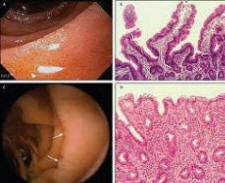CIDPUSA.org Autoimmune diseases
Celiac disease: When the body goes against the grain
Anatomy of celiac disease

The small intestine is lined with fingerlike projections, called villi, that absorb nutrients. In a healthy intestine, they resemble the rough surface of a shag carpet. In celiac disease, the immune system attacks the villi, causing them to flatten and become inflamed. Sometimes only a small portion of the intestine is affected. That's why some people with celiac disease have few or no symptoms and no signs of nutrient deficiencies.
"Celiac" comes from the Latin word for abdomen, but this digestive disease can cause symptoms throughout the body.
Wheat-based foods -- from a bagel for breakfast to pasta for dinner -- are a dietary staple for many people. But for a person with celiac disease, nibbling even a crumb of toast can spell trouble. Celiac disease (also known as celiac sprue) is an inherited intolerance to gluten, the sticky protein found in grains such as wheat, barley, and rye. For people with this condition, eating gluten can trigger immune system attacks that may ravage the lining of the small intestine, causing symptoms that include abdominal pain and bloating, diarrhea, and fatigue. Because the injured intestine can't adequately absorb vital nutrients (such as iron, calcium, and vitamin D), untreated celiac disease can lead to iron deficiency anemia, osteoporosis, lactose intolerance (the inability to digest or absorb lactose, a sugar found in milk and other dairy products), and other problems.
Celiac disease was once thought to be rare, but experts now estimate that in the United States, about 1 in 133 people -- two million in all -- have the disorder. It's more common among people of European ancestry (especially those from Italy, Ireland, and the Scandinavian countries), and it's slightly more prevalent in women.
Silent Celiac
Silent celiac disease is seen when people do not have the usual digestive symptoms of the Celiac when they consume gluten. While a person may not have symptoms or even an diagnosis of celiac, the damage to the intestines from the disease is still taking place. Following a strict gluten-free diet can be a life-changing decision for people with celiac, but it's the recommended treatment. A gluten-free diet may also help prevent certain related disorders, like inflammatory arthritis.Celiac incidence
It has been found that one in 141 Americans has celiac disease. Celiac disease is also more common in northern states in the U.S. and occurs more often in Caucasians.Celiac symptoms
A person with celiac disease who does not eat an entirely gluten-free diet could experience many medical issues, including abdominal pain, rashes, and even death.Discolored teeth, canker sores, itchy & blistring skin, arthritis, dry mouth and dry eyes, throiditis , diabitise or in some case merely fatigue.
Celiac foods to avoid
Pastas
raviolis, dumplings, couscous, and gnocchi Noodles: ramen, udon, soba (those made with only a percentage of buckwheat flour) chow mein, and egg noodles. (Note: rice noodles and mung bean noodles are gluten free)PBreads and Pastries
croissants, pita, naan, bagels, flatbreads, cornbread, potato bread, muffins, donuts, rollsCrackers
pretzels, goldfish, graham crackersBaked Goods
cakes, cookies, pie crusts, browniesCereal & Granola
corn flakes and rice puffs often contain malt extract/flavoring, granola often made with regular oats, not gluten-free oatsBreakfast Foods
a pancakes, waffles, french toast, crepes, and biscuits.Breading & Coating Mixes
panko breadcrumbs Croutons: stuffings, dressings Sauces & Gravies (many use wheat flour as a thickener) traditional soy sauce, cream sauces made with a roux Flour tortillas Beer (unless explicitly gluten-free) and any malt beverages , Brewer's Yeast.continue to celiac misdiagnosis page
reverse Alzheimer's